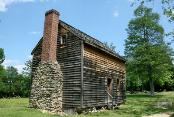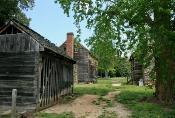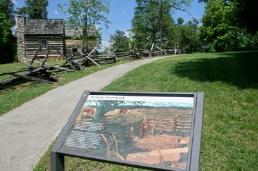

ExploreSouthernHistory.com - Tannenbaum Historical Park - North Carolina
ExploreSouthernHistory.com - Tannenbaum Historical Park - North Carolina

| Tannenbaum Historical Park A recreation of the Hoskins' Farm, a key landmark of the Battle of Guilford Courthouse, can be seen at Greensboro's Tannenbaum Historical Park. |
Tannenbaum Historical Park
The Hoskins house at the
park resembles the original
and dates from the early
1800s.
The Hoskins house at the
park resembles the original
and dates from the early
1800s.

Battle of Guilford Courthouse
British troops formed on the
grounds of Tannenbaum
Historic Park during the Battle
of Guilford Courthouse.
British troops formed on the
grounds of Tannenbaum
Historic Park during the Battle
of Guilford Courthouse.


Reconstructed Kitchen
The kitchen or "cook house"
has been reconstructed.
Unlike Southern kitchens of a
later era, it was not connected
to the house by a breezeway.
The kitchen or "cook house"
has been reconstructed.
Unlike Southern kitchens of a
later era, it was not connected
to the house by a breezeway.
Tannenbaum Historical Park - Greensboro, North Carolina
A Battle Begins at Hoskins Farm

A Farm of the Revolution
The reconstructed farm at the
park allows visitors to see the
Hoskins Farm as it appeared
in 1781.
The reconstructed farm at the
park allows visitors to see the
Hoskins Farm as it appeared
in 1781.
| Copyright 2011 by Dale Cox All rights reserved. |
When the British army of Lord Charles, Earl
Cornwallis, moved into action at the Battle of
Guilford Courthouse, it formed its lines on
the farm of Joseph Hoskins. Part of his lands
are now preserved at Tannebaum Historic
Park in Greensboro, North Carolina.
On March 15, 1781, having learned that his
American counterpart General Nathaniel
Greene had formed his army at Guilford
Courthouse, Cornwallis advanced up the
Great Salisbury Wagon Road (today's New
Garden Road) to meet him. As he reached
the 150-acre Hoskins Farm, the British
general's lead troops discovered the first
American line of battle formed behind a rail
fence with two pieces of cannon aimed
directly down the road.
To initiate his attack, Cornwallis moved his
1,800 men onto the grounds and fields of the
Hoskins Farm. There he formed his lines of
battle, deployed his own cannon, and
prepared for the coming fight. A fierce 30-
minute cannonade followed, with the British
troops then advancing forward across the
fields at the American militia waiting directly
ahead of them.
From this start, the Battle of Guilford
Courthouse would accelerate into one of the
key battles of the American Revolution. The
Americans under Greene would badly bloody
the British army and then retreat from the
field in good order.
Though he secured a tactical victory on the
ground, Cornwallis would be forced to fall
back to the coast at Wilmington in order to
secure supplies and regroup. By fall he
would be trapped at Yorktown and forced to
surrender. The bloody battle that began on
the Hoskins Farm set him on that road.
Like many families of the colonial era, the
Hoskins family had been devastated by the
American Revolution. When the conflict
erupted, the family was living on a farm in
Pennsylvania not far from a place called
Valley Forge. That was where, of course, the
American army of George Washington spent
the brutal winter of 1777.
The starving and freezing American soldiers
confiscated everything they could from local
farms, plunging many local families into dire
straits themselves.
To escape the difficulties that war brought to
their door, Joseph and Sarah Hoskins
decided to leave and relocate to the safety of
the Piedmont region of North Carolina. Their
new home was near a little wooden country
courthouse named Guilford.
The farmland here was good and there was
plenty of timber and water. It was remote
from the coastline and the locations at that
time of the British armies in America. There
was tension between loyalists and patriots in
the back country and occasional threats from
the Cherokee, but by and large the area was
safe.
Cornwallis, moved into action at the Battle of
Guilford Courthouse, it formed its lines on
the farm of Joseph Hoskins. Part of his lands
are now preserved at Tannebaum Historic
Park in Greensboro, North Carolina.
On March 15, 1781, having learned that his
American counterpart General Nathaniel
Greene had formed his army at Guilford
Courthouse, Cornwallis advanced up the
Great Salisbury Wagon Road (today's New
Garden Road) to meet him. As he reached
the 150-acre Hoskins Farm, the British
general's lead troops discovered the first
American line of battle formed behind a rail
fence with two pieces of cannon aimed
directly down the road.
To initiate his attack, Cornwallis moved his
1,800 men onto the grounds and fields of the
Hoskins Farm. There he formed his lines of
battle, deployed his own cannon, and
prepared for the coming fight. A fierce 30-
minute cannonade followed, with the British
troops then advancing forward across the
fields at the American militia waiting directly
ahead of them.
From this start, the Battle of Guilford
Courthouse would accelerate into one of the
key battles of the American Revolution. The
Americans under Greene would badly bloody
the British army and then retreat from the
field in good order.
Though he secured a tactical victory on the
ground, Cornwallis would be forced to fall
back to the coast at Wilmington in order to
secure supplies and regroup. By fall he
would be trapped at Yorktown and forced to
surrender. The bloody battle that began on
the Hoskins Farm set him on that road.
Like many families of the colonial era, the
Hoskins family had been devastated by the
American Revolution. When the conflict
erupted, the family was living on a farm in
Pennsylvania not far from a place called
Valley Forge. That was where, of course, the
American army of George Washington spent
the brutal winter of 1777.
The starving and freezing American soldiers
confiscated everything they could from local
farms, plunging many local families into dire
straits themselves.
To escape the difficulties that war brought to
their door, Joseph and Sarah Hoskins
decided to leave and relocate to the safety of
the Piedmont region of North Carolina. Their
new home was near a little wooden country
courthouse named Guilford.
The farmland here was good and there was
plenty of timber and water. It was remote
from the coastline and the locations at that
time of the British armies in America. There
was tension between loyalists and patriots in
the back country and occasional threats from
the Cherokee, but by and large the area was
safe.


Custom Search

From 1778, when they left Pennsylvania, until
1781, when the Battle of Guilford Courthouse
began on their lands, the Hoskins' worked to
open fields, plant and harvest crops, build
structures and otherwise start a new life for
themselves. Over that time they put together
a farm of 150-acres, with fields and gardens
surrounded by split-rail zigzag fences.
But then, in 1781, war again arrived on their
doorsteps. It began in February, when both
the American and British armies swept
through the area during the famed "Race to
the Dan." Nathaniel Greene won that race,
moving his army across the Dan River to
safety before Cornwallis could catch him.
The Battle of Guilford Courthouse followed
shortly after when Greene's reinforced army
crossed back into North Carolina and all but
challenged Cornwallis.
The farm, of course, suffered damage during
the battle, but the family survived and would
remain on the land for many years to come.
Tannenbaum Historic Park preserves a
clapboard-faced log cabin built by members
of the family in the early 1800s. Around it, a
forge, barn and kitchen recreate the farm as it
appeared during the battle. Interpretive
panels tell the story of the farm and its role in
the American Revolution.
The park is located at 2200 New Garden
Road in Greensboro, North Carolina, near
the entrance to Guilford Courthouse National
Military Park. There is no cost to visit.
The Colonial Heritage Center on the grounds
is a fascinating museum and interpretive
center. Please click here to learn more.
1781, when the Battle of Guilford Courthouse
began on their lands, the Hoskins' worked to
open fields, plant and harvest crops, build
structures and otherwise start a new life for
themselves. Over that time they put together
a farm of 150-acres, with fields and gardens
surrounded by split-rail zigzag fences.
But then, in 1781, war again arrived on their
doorsteps. It began in February, when both
the American and British armies swept
through the area during the famed "Race to
the Dan." Nathaniel Greene won that race,
moving his army across the Dan River to
safety before Cornwallis could catch him.
The Battle of Guilford Courthouse followed
shortly after when Greene's reinforced army
crossed back into North Carolina and all but
challenged Cornwallis.
The farm, of course, suffered damage during
the battle, but the family survived and would
remain on the land for many years to come.
Tannenbaum Historic Park preserves a
clapboard-faced log cabin built by members
of the family in the early 1800s. Around it, a
forge, barn and kitchen recreate the farm as it
appeared during the battle. Interpretive
panels tell the story of the farm and its role in
the American Revolution.
The park is located at 2200 New Garden
Road in Greensboro, North Carolina, near
the entrance to Guilford Courthouse National
Military Park. There is no cost to visit.
The Colonial Heritage Center on the grounds
is a fascinating museum and interpretive
center. Please click here to learn more.


Colonial Heritage Center
Battle of Guilford Courthouse
Battle of Cowpens
The Race to the Dan
Historic Sites in North Carolina
Explore other Southern Historic Sites
Battle of Guilford Courthouse
Battle of Cowpens
The Race to the Dan
Historic Sites in North Carolina
Explore other Southern Historic Sites
The Revolution in the Carolinas
Alamance Battleground - North Carolina
Fort Moultrie - South Carolina
Rutherford's Cherokee Campaign - North Carolina
Battle of Kings Mountain - South Carolina
Battle of Cowpens - South Carolina
The Race to the Dan - North Carolina & Virginia
Battle of Guilford Courthouse - North Carolina
Siege of Ninety Six - South Carolina
Alamance Battleground - North Carolina
Fort Moultrie - South Carolina
Rutherford's Cherokee Campaign - North Carolina
Battle of Kings Mountain - South Carolina
Battle of Cowpens - South Carolina
The Race to the Dan - North Carolina & Virginia
Battle of Guilford Courthouse - North Carolina
Siege of Ninety Six - South Carolina

